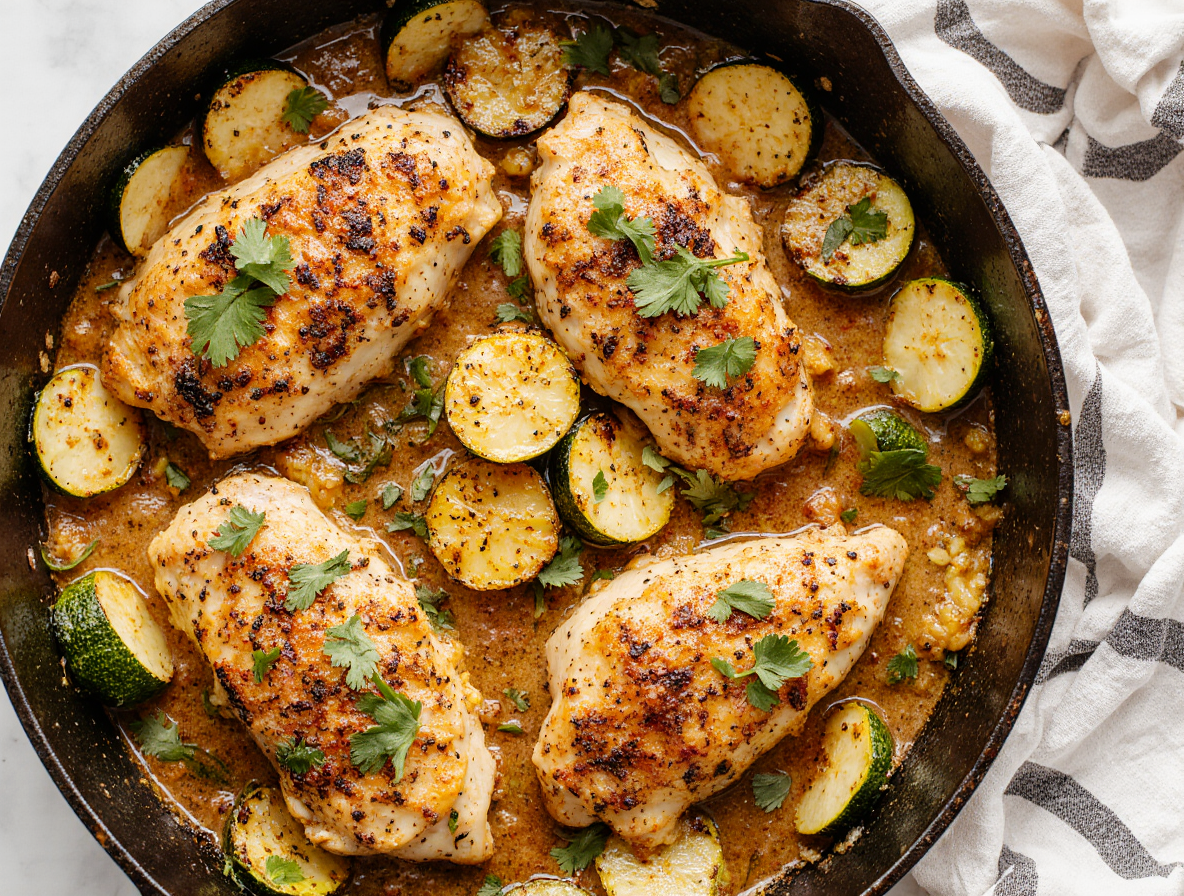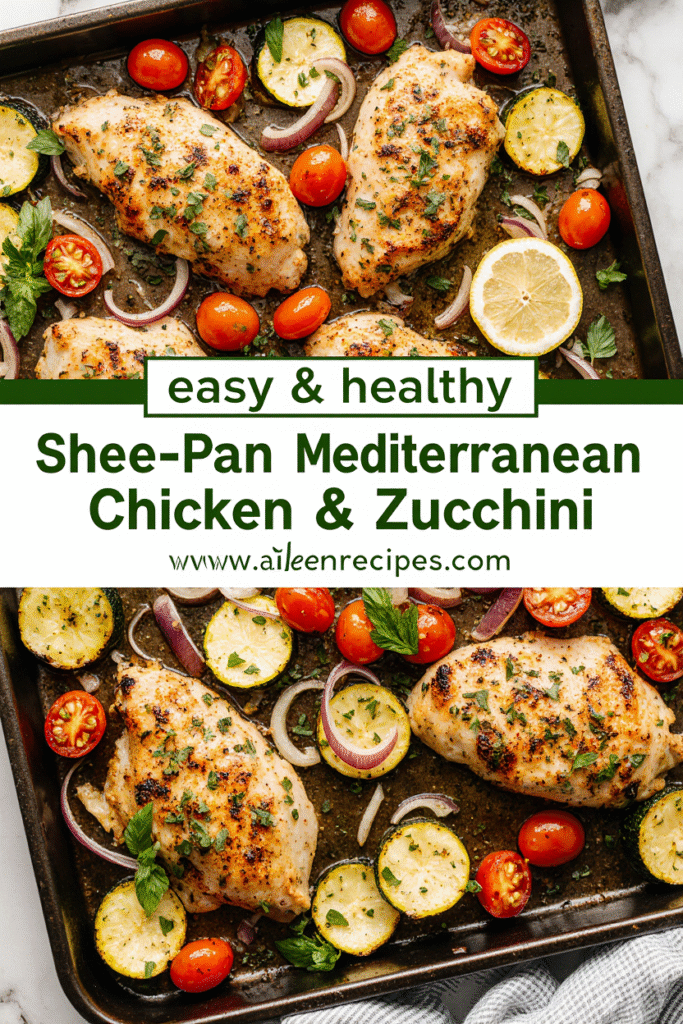The Perfect Mediterranean Sheet Pan Chicken: 30-Minute No-Mess Dinner Guide
Mediterranean sheet pan chicken has become our go-to solution when we need a delicious dinner on the table fast. This juicy, flavor-packed meal can be prepared in just 45 minutes, making it perfect for busy weeknights when cooking feels like a chore.
Sheet pan mediterranean chicken particularly shines because it combines the health benefits of the Mediterranean diet with the convenience of single-pan cooking. While mediterranean sheet pan recipes typically feature boneless, skinless chicken thighs that stay incredibly moist during cooking, these mediterranean sheet pan meals also incorporate colorful vegetables like zucchini, bell peppers, and tomatoes. In fact, mediterranean sheet pan dinners have gained popularity for their efficiency – a complete, nutritious meal with minimal cleanup. Depending on your family size, this mediterranean chicken sheet pan dinner can easily be doubled or tripled to feed larger groups, all while maintaining that signature Greek flavor from the versatile ladolemono sauce.
We’ll walk you through everything you need to know to create this 30-minute no-mess wonder that’s as healthy as it is delicious.
Essential Ingredients for Mediterranean Sheet Pan Chicken
Selecting the right ingredients makes all the difference between an ordinary chicken dinner and an extraordinary Mediterranean feast. The perfect combination creates that signature flavor profile we crave in Mediterranean cooking.
Chicken cuts: thighs vs. breasts
Boneless, skinless chicken thighs reign supreme in sheet pan cooking for good reason. Unlike chicken breasts, thighs contain more fat, resulting in richer flavor and juicier meat. Moreover, they’re incredibly forgiving – it’s nearly impossible to overcook them! Even if they exceed the recommended 165°F internal temperature by several minutes, they’ll remain tender and succulent rather than becoming dry and tough.
If you prefer chicken breasts, they can work too – just be vigilant about cooking time. For a sheet pan Mediterranean chicken using breasts, consider adding them to the pan 15-20 minutes after the vegetables start roasting since they cook faster and can dry out easily.
Vegetables that work best
The Mediterranean diet celebrates colorful, seasonal produce, and your sheet pan should too. The ideal vegetables for this dish include:
- Red onions (adds sweetness when roasted)
- Zucchini (sliced into half-moons works perfectly)
- Bell peppers (any color works beautifully)
- Cherry or grape tomatoes (burst during cooking to create natural sauce)
- Cauliflower florets (absorb flavors wonderfully)
These vegetables not only taste amazing together but also cook at similar rates. For winter variations, try substituting root vegetables, artichoke hearts, or even chickpeas.
The role of olives and feta
No Mediterranean sheet pan chicken would be complete without the briny punch of olives and the creamy tang of feta. Kalamata olives deliver that signature Mediterranean flavor, though you could substitute Castelvetrano for a milder, buttery taste. For feta, opt for blocks packed in brine rather than pre-crumbled versions – the flavor and texture are incomparably better.
These ingredients aren’t just garnishes; they transform the entire dish by adding salt, creaminess, and complexity that balances the other flavors.
Ladolemono: the signature Greek dressing
Ladolemono, which literally translates to “lemony olive oil,” is the secret weapon that elevates this dish. This classic Greek dressing follows a simple 1:3 ratio – one part fresh lemon juice to three parts quality extra virgin olive oil. Additionally, dried oregano and minced garlic are often added for extra flavor.
Beyond its role as a marinade, ladolemono creates a bright, emulsified sauce that ties all the ingredients together. When selecting olive oil for this purpose, choose a high-quality extra virgin variety with a slightly bitter, rich taste that will truly shine in this simple preparation.
Step-by-Step Guide to Cooking the Perfect Sheet Pan Chicken
Creating the perfect Mediterranean sheet pan chicken is about timing and technique rather than complicated culinary skills. Once you’ve gathered your ingredients, the cooking process follows a logical sequence that guarantees delicious results every time.
Prepping the oven and pan
Success starts with proper preparation. First, position a rack in the center of your oven and preheat to 425°F. This high temperature ensures proper browning and caramelization without drying out your chicken. Meanwhile, prepare your sheet pan by lining it with parchment paper or aluminum foil for easier cleanup. Alternatively, a light coating of cooking spray works well too.
Marinating the chicken and veggies
The marinade brings everything together. Whisk your ladolemono dressing until emulsified, then divide it – approximately two-thirds for the chicken and one-third for the vegetables. In a large bowl, toss your chicken thighs with their portion of the marinade until thoroughly coated. Let them sit for 10-15 minutes to absorb the flavors. Subsequently, in a separate bowl, toss your prepped vegetables with their share of the dressing.
Layering ingredients for even cooking
How you arrange ingredients on your sheet pan directly affects cooking performance. Spread vegetables evenly across the pan surface, ensuring they touch the hot metal for proper caramelization. Next, nestle the marinated chicken pieces among the vegetables, keeping them slightly elevated when possible. This arrangement allows hot air to circulate around each piece. Place larger, denser vegetables like potatoes around the perimeter where the pan gets hottest.
Baking and broiling for color and texture
Bake the sheet pan dinner for approximately 30-35 minutes until chicken reaches an internal temperature of 165°F. Furthermore, for that restaurant-quality finish, switch your oven to broil for the final 3-5 minutes. Watch carefully during this stage as the high heat will quickly brown the chicken skin and slightly char the vegetables’ edges. After removing from the oven, allow everything to rest for 5 minutes before serving, which helps the juices redistribute throughout the chicken.
Smart Tips and Substitutions for Any Season
The beauty of Mediterranean sheet pan chicken lies in its flexibility – this adaptable recipe works year-round with simple adjustments to ingredients and cooking techniques.
Vegetable swaps for winter and summer
One of the greatest advantages of mediterranean sheet pan recipes is their seasonal versatility. During summer months, zucchini, bell peppers, and grape tomatoes create a vibrant, colorful meal. Alternatively, when winter arrives, swap in heartier options like cauliflower, brussels sprouts, parsnips, or root vegetables. Essentially, any vegetable cut to similar size will work beautifully in this dish. Artichoke hearts make an excellent addition regardless of season – canned varieties are particularly convenient and roast wonderfully alongside chicken.
Using different herbs and spices
While oregano forms the foundation of traditional mediterranean sheet pan meals, don’t hesitate to experiment. Fresh dill offers a unique flavor profile, especially delightful in spring. Infused olive oils provide all the flavor without FODMAPs for those with sensitivities. Rosemary, sage, and even mint can transform your mediterranean chicken sheet pan dinner into something new entirely. Simply adjust the herb-oil-lemon mixture according to your preference.
Making it dairy-free or low-carb
For dairy-free versions, substitute dairy-free yogurt or sour cream for the traditional Greek yogurt in tzatziki sauce. Alternatively, skip the feta altogether or use nutritional yeast for a cheesy flavor. To create a low-carb mediterranean sheet pan dinner, replace potatoes with cauliflower florets or artichoke hearts. Obviously, this versatile meal adapts easily to specialized diets without sacrificing flavor.
How to avoid overcooking chicken
The most common mistake with chicken breasts is overcooking them. Certainly, nobody wants undercooked chicken, but overcompensating leads to dry, chalky texture. Invest in a meat thermometer and pull chicken at 157°F – it will reach the safe 165°F through carryover cooking during resting. Notably, chicken thighs are more forgiving than breasts, remaining juicy even when cooked slightly longer. Consequently, let your chicken rest at least half the time you cooked it before slicing to maintain maximum juiciness.
Serving, Storing, and Reheating Your Mediterranean Chicken
Mediterranean sheet pan chicken shines beyond its initial serving, becoming even more valuable as part of your meal prep strategy. Let me show you how to get the most out of this versatile dish from serving to reheating.
Best sides to serve with it
My Mediterranean sheet pan chicken truly sings when paired with the right accompaniments. A simple bed of basmati rice or quinoa makes an excellent foundation, soaking up those flavorful pan juices. For a lighter option, toss the chicken and roasted vegetables with arugula to create a bright, satisfying salad. Fresh pita bread or homemade focaccia provides the perfect vehicle for scooping up every last morsel. Alternatively, traditional Greek salad offers a refreshing contrast with its crunchy vegetables and tangy dressing.
How to store leftovers properly
After cooking, allow your Mediterranean sheet pan chicken to cool completely before storing. Place leftovers in airtight containers within two hours of cooking to prevent bacterial growth. Properly stored chicken will remain fresh in the refrigerator for 3-4 days. Keep chicken and vegetables in separate containers for best results, as vegetables release moisture that can affect the chicken’s texture over time.
Freezing and defrosting tips
To freeze leftover Mediterranean sheet pan chicken, transfer cooled portions to freezer-safe containers, removing as much air as possible. Frozen chicken maintains quality for up to 3 months. When ready to enjoy, thaw overnight in the refrigerator—never at room temperature. Remember that high-moisture vegetables like zucchini and tomatoes may become slightly watery when thawed but will still taste delicious.
Reheating without drying it out
For perfectly reheated chicken, the oven method yields superior results. Preheat to 350°F, place chicken in an oven-safe dish, add a splash of water or broth, and cover tightly with foil. Heat until the internal temperature reaches 165°F. Alternatively, stovetop reheating works wonderfully for boneless pieces—simply add a little liquid to a small pot, cover, and warm over medium-low heat. For crispy skin, finish under the broiler for a minute or two.
Conclusion
Mediterranean sheet pan chicken truly stands out as a weeknight dinner superhero. Throughout this guide, we’ve explored why this dish deserves a regular spot in your meal rotation. Quick preparation, minimal cleanup, and maximum flavor make it the perfect solution for busy evenings when cooking feels overwhelming.
The beauty of this dish lies in its adaptability. Chicken thighs offer forgiveness and juiciness, though chicken breasts work well with proper timing. Colorful vegetables create not just visual appeal but nutritional balance. Additionally, the signature ladolemono dressing brings everything together with its perfect blend of lemon brightness and rich olive oil.
We love how this dish transforms across seasons. Summer calls for zucchini and tomatoes, while winter welcomes heartier root vegetables – all working perfectly with the same cooking method. The dish accommodates dietary needs effortlessly, whether you’re avoiding dairy or limiting carbs.
Last but certainly not least, leftovers shine almost brighter than the original meal. Proper storage techniques ensure your Mediterranean chicken remains delicious for days afterward, ready to be transformed into lunch salads or quick dinners.
Now that you have all the knowledge needed to create this Mediterranean masterpiece, it’s time to grab that sheet pan and get cooking! Your 30-minute no-mess dinner awaits, promising both convenience and the wonderful flavors of Mediterranean cuisine. Trust me, once you try this approach, ordinary weeknight dinners will never look the same again.
FAQs
Q1. What makes Mediterranean sheet pan chicken a great weeknight dinner option? Mediterranean sheet pan chicken is perfect for busy weeknights because it can be prepared in just 30-45 minutes, requires minimal cleanup, and offers a delicious, nutritious meal with the health benefits of the Mediterranean diet.
Q2. Which chicken cut works best for this recipe? Boneless, skinless chicken thighs are ideal for sheet pan cooking. They’re more flavorful, juicier, and more forgiving than chicken breasts, making it difficult to overcook them.
Q3. Can I customize the vegetables in this dish? Absolutely! While the recipe suggests vegetables like red onions, zucchini, bell peppers, and cherry tomatoes, you can easily swap these based on seasonal availability or personal preference. Root vegetables and chickpeas work well in winter variations.
Q4. What is ladolemono and why is it important in this recipe? Ladolemono is a classic Greek dressing made from lemon juice, olive oil, oregano, and garlic. It’s crucial in this recipe as it serves as both a marinade and a flavorful sauce that ties all the ingredients together.
Q5. How can I store and reheat leftovers? Store cooled leftovers in airtight containers in the refrigerator for 3-4 days. To reheat, place the chicken in an oven-safe dish with a splash of water or broth, cover with foil, and heat at 350°F until the internal temperature reaches 165°F. This method helps prevent the chicken from drying out.


